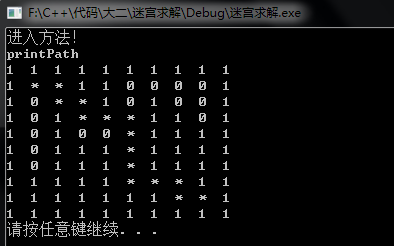一:迷宫求解
是一个锻炼我们的算法求解能力的问题,它的实现方法有很多;今天我们就介绍其中的用栈求解的方法。
二:什么是栈:
大家应该都有往袋子里装东西的经历,在往袋子里装满东西之后,当我们去取的时候,总是先从最后放进去的东西的地方去取。也就是后进先出(FILO)。虽然栈的单向性用起来会没有链表那样可以在任意位置对数据进行操作,但是正因为如此栈也带来了很大的方便。
三:迷宫求解
现在我们要在下面的迷宫寻找一条可行的路径
?
|
1
2
3
4
5
6
7
8
9
10
|
1 1 1 1 1 1 1 1 1 1
1 0 0 1 1 0 0 0 0 1
1 0 0 0 1 0 1 0 0 1
1 0 1 0 0 0 1 1 0 1
1 0 1 0 0 0 1 1 1 1
1 0 1 1 1 0 1 1 1 1
1 0 1 1 1 0 1 1 1 1
1 1 1 1 1 0 0 0 1 1
1 1 1 1 1 1 1 0 0 1
1 1 1 1 1 1 1 1 1 1
|
首先我们需要在程序中表示上面的迷宫,该问题可以用数组实现
1:栈的定义
?
|
1
2
3
4
5
6
7
8
9
10
11
12
13
14
15
16
17
18
19
20
21
22
23
24
25
26
27
28
29
30
31
32
33
34
35
36
37
38
39
40
41
42
43
44
45
46
47
48
49
50
51
52
53
54
55
56
|
/************************************************************************/
/*自定义栈 */
/*通过自定义的简单栈以满足迷宫求解 */
/*功能:push() 将元素加入栈中 */
/* pop() 退栈;topValue() 获得栈顶元素 */
/* clear() 清除栈 length() 获得栈中元素个数*/
/************************************************************************/
#include <stack>
#include <iostream>
using namespace std;
template<typename Elem> class PathStack: public stack<Elem>
{
private:
int size;
int top;
Elem* listArray;
public:
PathStack(int sz = DefaultListSize){
size = sz;
top = 0;
listArray = new Elem[sz];
}
~PathStack(){ delete []listArray; }
void clear(){ top = 0; }
/****向栈中加入元素****/
bool push(const Elem& item);
/***********退栈**********/
Elem pop();
/********获得栈顶元素*******/
Elem topValue() const;
int length() const { return top; }
};
template<typename Elem>
bool PathStack<typename Elem>::push(const Elem& item){
if(top == size) return false;
listArray[top++] = item;
return true;
}
template<typename Elem>
Elem PathStack<typename Elem>::pop(){
Elem it;
if(top == 0) return it;
it = listArray[--top];
return it;
}
template<typename Elem>
Elem PathStack<typename Elem>::topValue() const{
Elem it;
if(top == 0) return it;
it = listArray[top - 1];
return it;
}
|
2:如何实现路径的寻找
1:设定寻找的方向,可以使用一个判断语句;判断起始位置周围哪个地方有路就将该位置的坐标加入到栈中,并将该位置标记(将改位置值改为2,既将走过的位置标记为2)
2:判断该位置周围是否还有路,若没有则退栈即退回到上一个位置;并将该位置做下另一个标记(将该位置值改为3,既将退栈位置值用3标记)
3:重复1,2步骤直到达到出口
路径寻找的类:
?
|
1
2
3
4
5
6
7
8
9
10
11
12
13
14
15
16
17
18
19
20
21
22
23
24
25
26
27
28
29
30
31
32
33
34
35
36
37
38
39
40
41
42
43
44
45
46
47
48
49
50
51
52
53
54
55
56
57
58
59
60
61
62
63
64
65
66
67
68
69
70
71
72
73
74
75
76
77
78
79
80
81
82
83
84
85
86
87
88
|
//迷宫求解的方法类
//功能:通过findPath() 方法实现对路径的查找
// 通过printPath()方法将路径打印出来
#include "PathStack.h"
#include <iostream>
using namespace std;
class MazeSolveMethod
{
private:
static int maze[10][10];//存放迷宫数据
PathStack<int> pathStack;//定义栈
public:
MazeSolveMethod():pathStack(100){
}
~MazeSolveMethod(){ }
void findPath(int startX,int startY);
void printPath() const;
};
int MazeSolveMethod::maze[10][10] = {
{1,1,1,1,1,1,1,1,1,1},
{1,0,0,1,1,0,0,0,0,1},
{1,0,0,0,1,0,1,0,0,1},
{1,0,1,0,0,0,1,1,0,1},
{1,0,1,0,0,0,1,1,1,1},
{1,0,1,1,1,0,1,1,1,1},
{1,0,1,1,1,0,1,1,1,1},
{1,1,1,1,1,0,0,0,1,1},
{1,1,1,1,1,1,1,0,0,1},
{1,1,1,1,1,1,1,1,1,1},
};
void MazeSolveMethod::findPath(int startX,int startY){
int x = startX;
int y = startY;
pathStack.push(x);
pathStack.push(y);
maze[x][y] = 2;
cout<<"进入方法!"<<endl;
while(true){
if(maze[x-1][y] == 0){
pathStack.push(--x);
pathStack.push(y);
maze[x][y] = 2;
}else if(maze[x][y-1] == 0){
pathStack.push(x);
pathStack.push(--y);
maze[x][y] = 2;
}else if(maze[x][y+1] == 0){
pathStack.push(x);
pathStack.push(++y);
maze[x][y] = 2;
}else if(maze[x+1][y] == 0){
pathStack.push(++x);
pathStack.push(y);
maze[x][y] = 2;
}
if(maze[x-1][y] != 0 && maze[x][y+1] != 0 && maze[x+1][y] != 0 && maze[x][y-1] != 0){
if(x >= 8 && y >= 8){
break;
}else{
maze[x][y] = 3;
y = pathStack.pop();
x = pathStack.pop();
}
y = pathStack.topValue();
int temp = pathStack.pop();
x = pathStack.topValue();
pathStack.push(temp);
}
}
}
void MazeSolveMethod::printPath() const{
cout<<"printPath"<<endl;
for(int i=0; i<10; i++){
for(int j=0; j<10; j++){
if(maze[i][j] == 2)
cout<<'*'<<" ";
else if(maze[i][j] == 3)
cout<<0<<" ";
else
cout<<1<<" ";
}
cout<<endl;
}
}
|
主函数类
?
|
1
2
3
4
5
6
7
8
9
10
11
12
13
14
15
16
17
18
19
|
/************************************************************************/
/*迷宫求解----栈方法实现*/
//功能:通过对栈实现迷宫算法求解
//Author:Andrew
//Date :2012-10-20
/************************************************************************/
#include "MazeSolveMethod.h"
#include <iostream>
using std::cout;
using std::endl;
int main(){
MazeSolveMethod solve;
solve.findPath(1,1);
solve.printPath();
system("pause");
return 0;
}
|
将上面的代码运行后结果截图如下:
其中* 为路径
感谢阅读,希望能帮助到大家,谢谢大家对本站的支持!
相关文章
猜你喜欢
- 64M VPS建站:是否适合初学者操作和管理? 2025-06-10
- ASP.NET自助建站系统中的用户注册和登录功能定制方法 2025-06-10
- ASP.NET自助建站系统的域名绑定与解析教程 2025-06-10
- 个人服务器网站搭建:如何选择合适的服务器提供商? 2025-06-10
- ASP.NET自助建站系统中如何实现多语言支持? 2025-06-10
TA的动态
- 2025-07-10 怎样使用阿里云的安全工具进行服务器漏洞扫描和修复?
- 2025-07-10 怎样使用命令行工具优化Linux云服务器的Ping性能?
- 2025-07-10 怎样使用Xshell连接华为云服务器,实现高效远程管理?
- 2025-07-10 怎样利用云服务器D盘搭建稳定、高效的网站托管环境?
- 2025-07-10 怎样使用阿里云的安全组功能来增强服务器防火墙的安全性?
快网idc优惠网
QQ交流群
您的支持,是我们最大的动力!
热门文章
-
2025-05-25 71
-
ASP.NET Core 3框架揭秘之 异步线程无法使用IServiceProvider问题
2025-05-29 49 -
2025-05-29 16
-
2025-05-25 98
-
详解Java中的checked异常和unchecked异常区别
2025-05-29 62
热门评论











